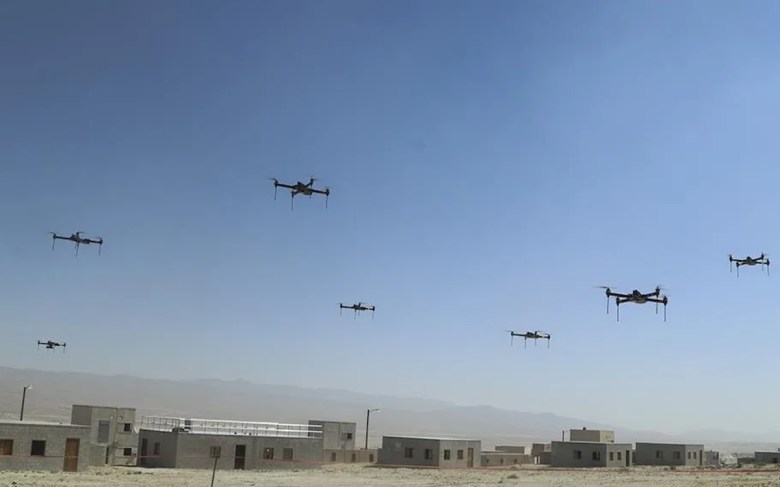Sports
US Army Showcases Cutting-Edge Drone Technology in Washington

The annual Association of the US Army exhibition, held in Washington, D.C., from October 13 to 15, 2023, highlighted a significant emphasis on drone technology and counter-drone capabilities. The event featured an array of innovative products designed to address the evolving needs of modern military operations. Notable ground systems showcased included the Oshkosh Striker equipped with the new Medium Caliber Weapon System and the AM General MIMIC-V, tailored for special operations.
A prominent theme at this year’s show was the integration of technologies aimed at countering unmanned aerial systems (UAS). The ongoing conflict in Ukraine has dramatically altered the landscape of land warfare, complicating the use of traditional armored platforms, such as tanks and infantry fighting vehicles, in a combat environment dominated by drones. In response, military strategies have shifted towards deploying smaller units of three to five soldiers to achieve specific operational objectives.
As both Russian and Ukrainian forces increasingly rely on drones for precision strikes, the need for effective counter-drone solutions has become paramount. The exhibition featured various systems designed to improve detection and neutralization of aerial threats. For instance, General Dynamics presented the PERCH and MUTT XM, which integrate loitering munitions and Gatling guns to combat UAS.
Advancements in Drone Detection and Neutralization
At the core of effective counter-drone systems is the ability to detect and identify threats early. Several exhibitors showcased advanced sensor technologies, including long-range thermal cameras and radio frequency (RF) detection systems. For example, Motorola Solutions displayed an integrated network of RF sensors and thermal cameras designed to track drones and locate their operators, enhancing early warning capabilities in low-visibility conditions.
Once a drone is detected, neutralization often relies on non-kinetic methods such as RF jamming and signal spoofing. Trust Automation introduced its GATTM UAS jammer, a compact device that disrupts drone communications without physical destruction. This technology is particularly valuable in scenarios where collateral damage must be minimized, such as near civilian areas or critical infrastructure.
As drones become more autonomous, countermeasures must adapt. Jammers are increasingly focusing on reconnaissance drones, which rely on communication, rather than combat drones that may operate independently. Meanwhile, directed-energy weapons, such as high-energy lasers, are gaining traction for their ability to neutralize multiple drones quickly. Previous AUSA exhibitions featured systems like the Stryker-mounted laser weapons from Leonardo DRS, designed for precise mid-flight destruction of drones.
Innovative Solutions for Modern Warfare
Another notable technology showcased was the Iron Drone Raider by Ondas, which employs autonomous drones to intercept and disable enemy UAS in flight. This drone-on-drone defense system represents a shift towards AI-enabled platforms that can respond to threats independently, thus improving reaction times and reducing the workload on operators.
The systems presented at the AUSA are not just about technology; they also integrate advanced command and control (C2) platforms, enabling military forces to streamline decision-making processes and automate responses. Motorola Solutions partnered with SkySafe to develop a software-as-a-service (SaaS) control system that combines drone tracking data with situational awareness tools.
Flexibility and rapid deployment remain crucial for modern counter-unmanned aerial systems (C-UAS). Exhibitors like Trust Automation highlighted modular systems, such as the Small-Unmanned Air Defense System (SUADS), capable of supporting both fixed-base and mobile operations. These adaptable solutions can protect military convoys, secure remote outposts, or defend urban areas.
The technologies displayed at AUSA 2023 respond directly to the operational challenges posed by the increasing use of drone swarms in combat. Joint Army experiments have validated systems capable of detecting and defeating over 40 drones simultaneously. The proliferation of low-cost commercial drones has made them accessible to insurgents and hostile actors, necessitating adaptable defenses sensitive to the complexities of modern warfare.
Despite the advances showcased, the US Army faces significant challenges in addressing the evolving drone threat. As demonstrated by the recent modernization of the Russian Geran-2 drone, which incorporates artificial intelligence for target identification, the military must remain vigilant and innovative. Current sanctions and technological restrictions may not effectively curb the rapid advancement of drone capabilities.
In conclusion, while the US Army is making strides in countering drone warfare, a proactive approach is essential. As the landscape of modern combat continues to evolve, the military must develop comprehensive solutions that keep pace with these changes. The exhibition underscored a clear message: the future of warfare will increasingly hinge on the ability to navigate and neutralize the threats posed by unmanned aerial systems.
-

 Business5 months ago
Business5 months agoKenvue Dismisses CEO Thibaut Mongon as Strategic Review Advances
-

 Lifestyle4 months ago
Lifestyle4 months agoHumanism Camp Engages 250 Youths in Summer Fest 2025
-

 Sports4 months ago
Sports4 months agoDe Minaur Triumphs at Washington Open After Thrilling Comeback
-

 Sports5 months ago
Sports5 months agoTupou and Daugunu Join First Nations Squad for Lions Clash
-

 Top Stories5 months ago
Top Stories5 months agoColombian Senator Miguel Uribe Shows Signs of Recovery After Attack
-

 World5 months ago
World5 months agoASEAN Gears Up for Historic Joint Meeting of Foreign and Economic Ministers
-

 Health4 months ago
Health4 months agoNew Study Challenges Assumptions About Aging and Inflammation
-

 Business5 months ago
Business5 months agoOil Prices Surge Following New EU Sanctions on Russia
-

 Entertainment4 months ago
Entertainment4 months agoDetaşe-Sabah Violin Ensemble Captivates at Gabala Music Festival
-

 Entertainment4 months ago
Entertainment4 months agoBaku Metro Extends Hours for Justin Timberlake Concert
-

 Top Stories5 months ago
Top Stories5 months agoRethinking Singapore’s F&B Regulations Amid Business Closures
-

 Business5 months ago
Business5 months agoU.S. House Approves Stablecoin Bill, Sends to Trump for Signature









